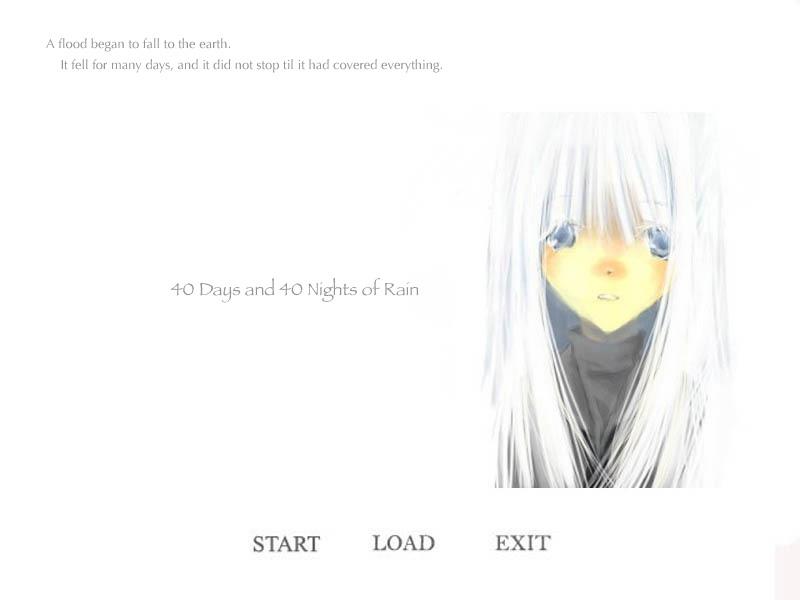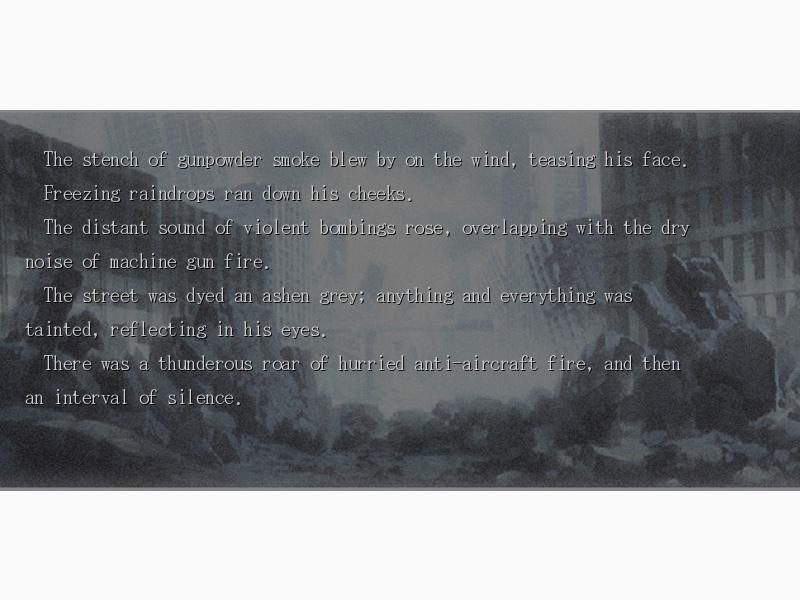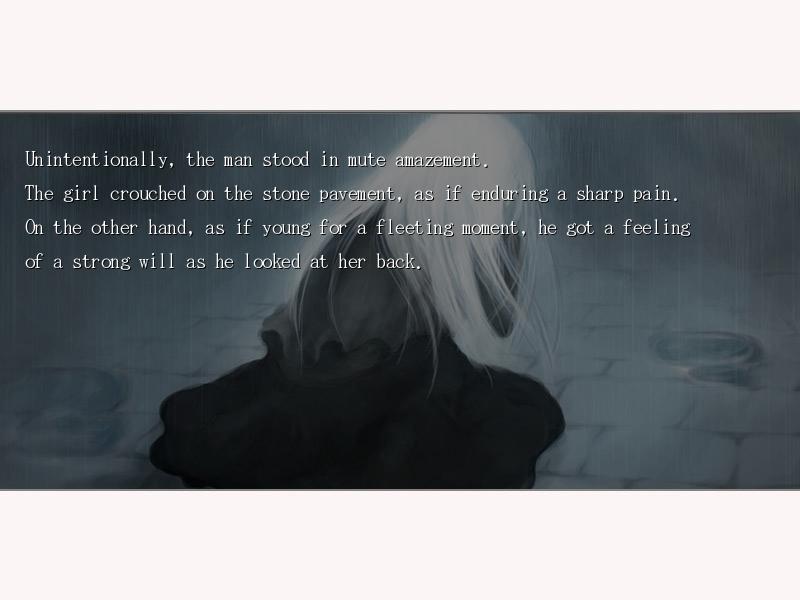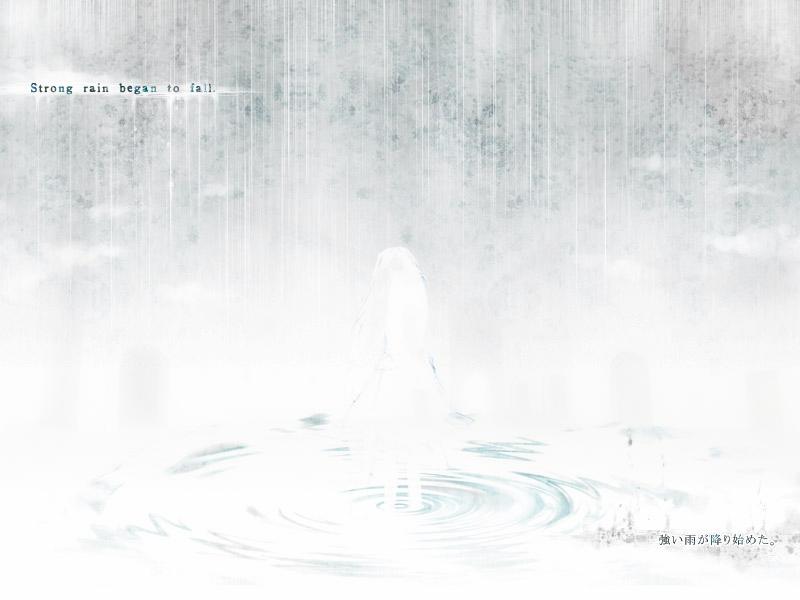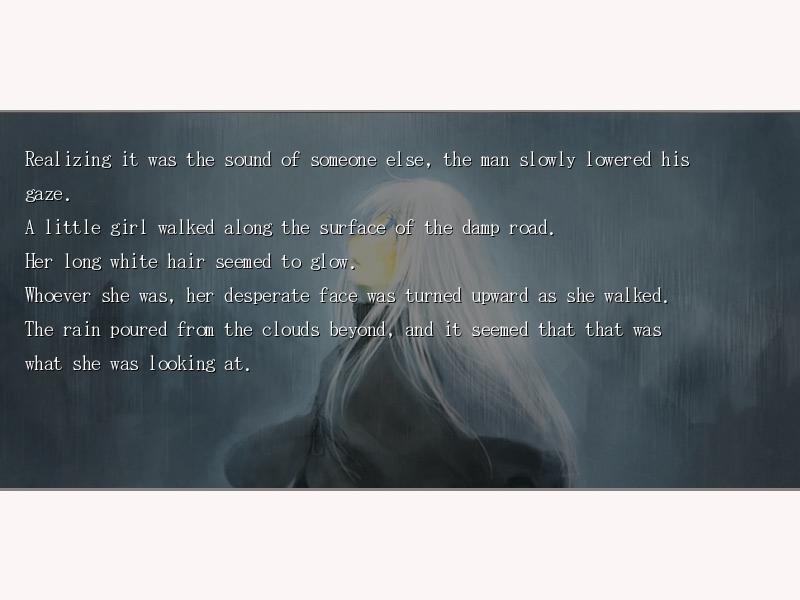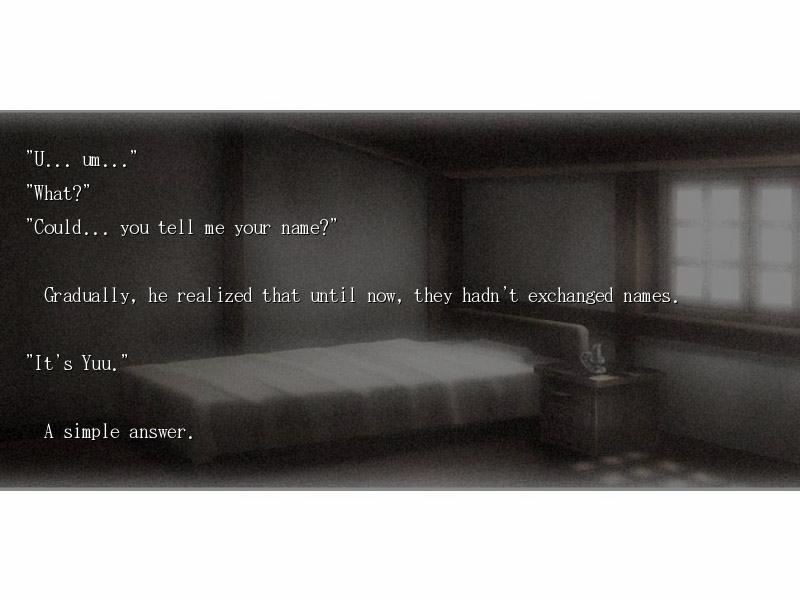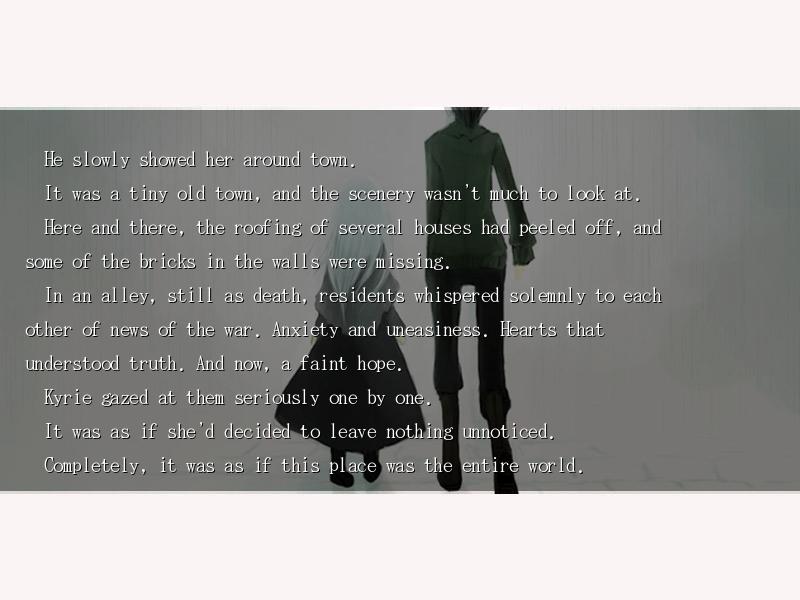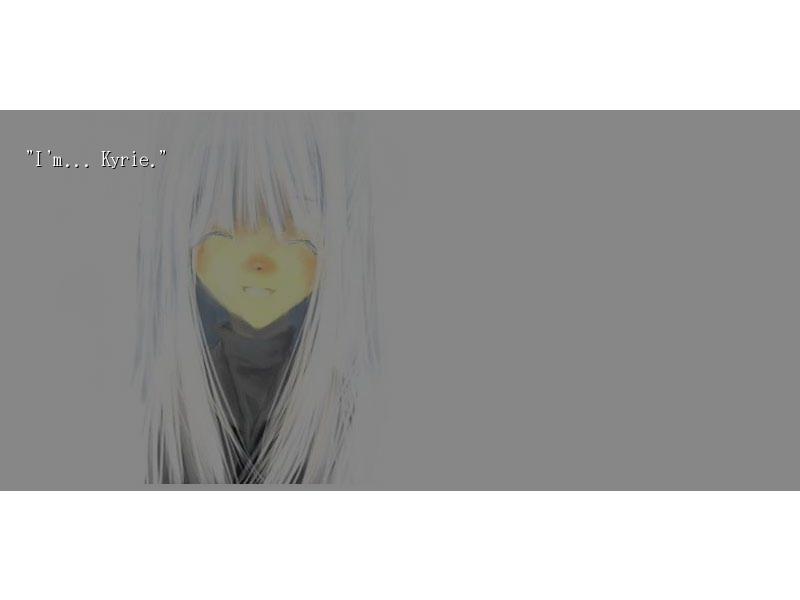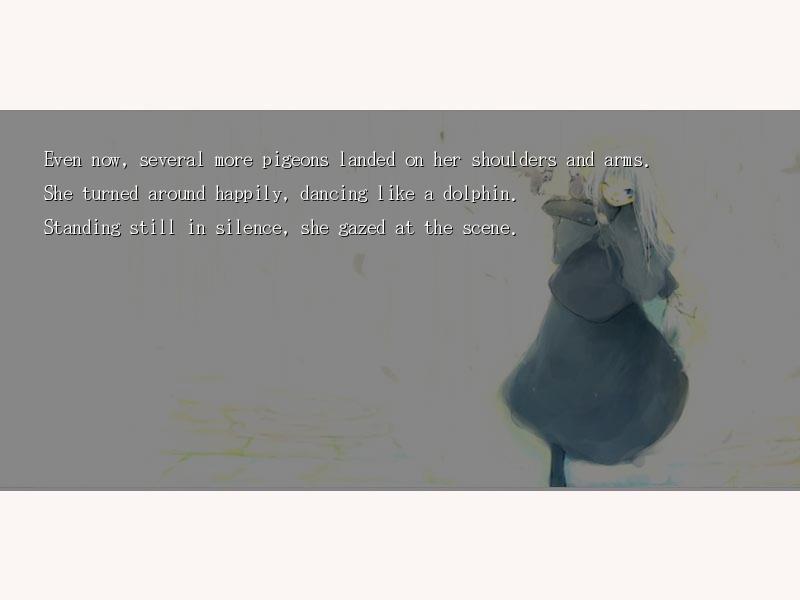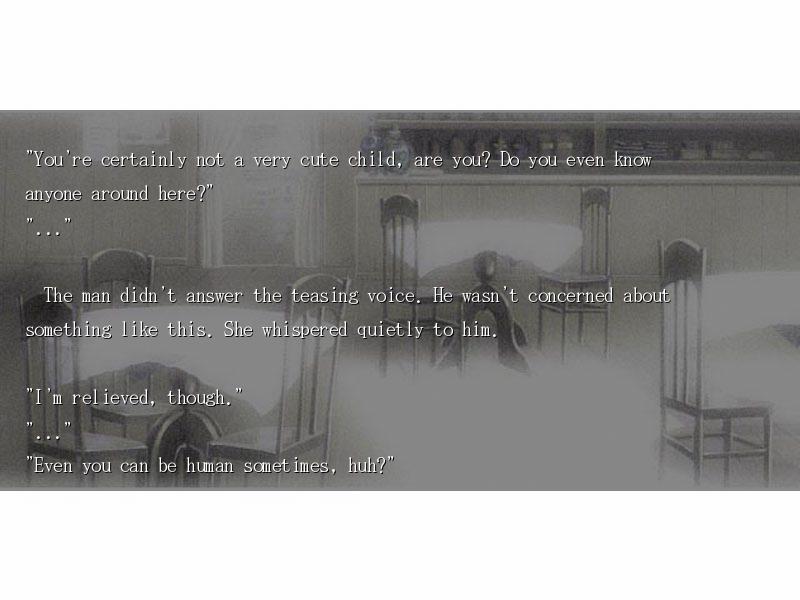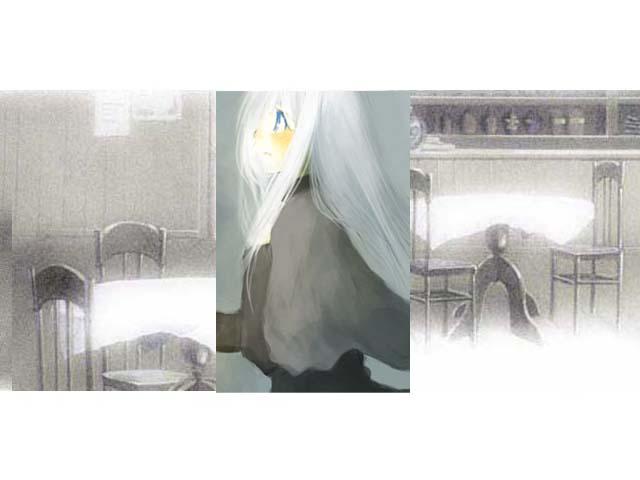I have reviewed many visual novels here at The New Leaf Journal, but never, until now, have I reviewed two separate visual novels in one article (I have however reviewed two two-part visual novels in I, Too, Saw Dreams Through Air and The world to reverse. This article will be focused in the main on 40 Days and 40 Nights of Rain, which is the unofficial English-language localization of a freeware doujin Japanese visual novel called 40-nichi 40-ya no Ame. 40 Days tells a full story and takes somewhere in the neighborhood of one hour and change to read.
A flood began to fall to the earth
It fell for many days, and it did not stop till it had covered everything.
Top-left title screen text for 40 Days and 40 Nights of Rain
I will additionally look at A Happy Valentine, which is the unofficial localization of a freeware Japanese visual novel of the same name. A Happy Valentine is a side-story to 40 Days and takes about 5-10 minutes to read. Because A Happy Valentine takes place within the confines of 40 Days and is very short, it makes sense to review it together with its parent novel.
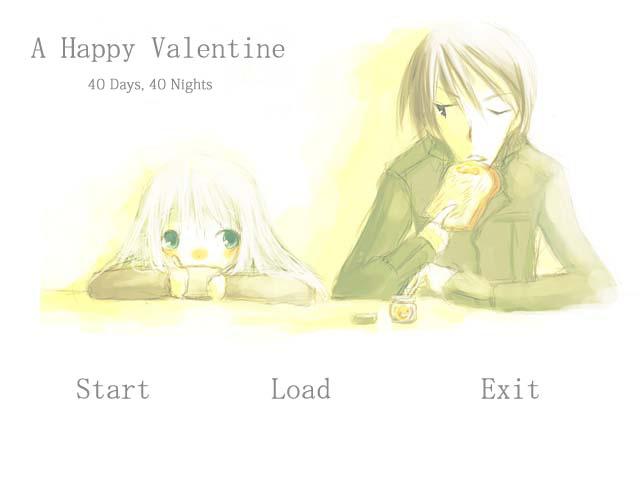
40 Days and 40 Nights of Rain is an entirely kinetic (no choices) visual novel set in a war-torn world in an unknown time and place. The view-point character, Yuu, is a battle-scarred soldier on brief leave from fighting in the apparently endless war. Yuu, referred to as “Tin Plate” by those around him for his apparent lack of emotion, encounters a peculiar white-haired girl with a tendency to fall down and burst into tears. Yuu and the other residents and patrons of an unnamed inn a town that is not yet on the front line come to care for that strange girl, Kyrie.
(This set-up may sound vaguely familiar to people who read my February 2024 review of True Remembrance or read that novel. We will cover the similarities in this review.)
40 Days and 40 Nights of Rain Details
The underlying Japanese novel 40-nichi 40-ya no Ame was developed by ZIGZAG and released in Japan in January of 2007. Its side-story spin-off A Happy Valentine was released in Japan in February 2007. Here I will note that ZIGZAG is (or was – see archived website) a fairly prolific doujin visual novel circle in Japan, being credited with 13 visual novels released between 2006 and 2017. Several of them have been localized by English translation circles.
- VNDB entry for 40 Days and 40 Nights of Rain
- VNDB entry for A Happy Valentine
- 2007 Visual Novels Net review of 40 Days and 40 Nights of Rain
- 2008 Visual Novels Net review of A Happy Valentine
- Archived Copy of Deja Vu’s webpage for 40 Days and 40 Nights of Rain
I will be reviewing Deja Vu’s localizations of 40 Days and 40 Nights of Rain and A Happy Valentine. Deja Vu released the former in April 2007 and A Happy Valentine on February 21, 2008. The original Japanese novels were written in NScripter and Deja Vu’s localizations were written in ONScripter-EN. These are the second and third Deja Vu localizations that we have reviewed at The New Leaf Journal. Deja Vu also contributed its A Dream of Summer localization to the al|together 2006 visual novel festival, and I reviewed A Dream of Summer as part of my al|together project. Neither 40 Days nor A Happy Valentine were part of al|together, but they were released between the second and third al|together festivals.
The original Japanese novels were written in NScripter. Deja Vu’s localizations were written in an earlier version of ONScripter-EN.
In 2014 – a group called 6YDIA released re-coded works of several of Deja Vu’s visual novel projects, including both 40 Days and 40 Nights of Rain and A Happy Valentine. They produced the novels in Unity instead of ONScripter-EN and released versions for Windows, Linux, and OSX. I tested the 6DIYA Unity release of 40 Days and found that it appears to work as expected – but note that my review is of the original ONScripter-EN releases by Deja Vu. Some readers who are interested in trying the novels for themselves may have an easier time with the 6DIYA versions, both of which are available on 6DIYA’s website.
Downloading and Running Deja Vu’s 40 Days and A Happy Valentine
Deja Vu’s website is no longer online (it appears to have been offline since at least 2017). However, both 40 Days and 40 Nights of Rain and A Happy Valentine can still be downloaded from links on the Visual Novel Database (40 Days and A Happy Valentine) and from Kaisernet’s ONScripter Corner. These downloads yield the Windows installer. I explained in an earlier article that one can extract the contents of an ONScripter-EN Windows installer and use a Linux ONScripter-EN executable in the extracted directory to run the novel natively on Linux. I tried this and while I was able to run 40 Days natively on Linux, I could not get the music (it uses MIDI) to work with the newest 2024 release of ONScripter-EN. I also tried the last 2011 ONScripter-EN build, which has resolved MIDI music issues in some cases (see e.g., My Black Cat), but I ran into the same error here. Thus, I ran the Windows version of 40 Days on Linux on top of WINE – which worked perfectly.
I replaced the ONScripter-EN executable which comes from the installer with the new 2024 Windows ONScripter-EN binary (2024-07-21 in my case) and it worked also with WINE. I did not test A Happy Valentine with a Linux ONScripter-EN executable, instead opting to run the Windows version on WINE in the same way I ran 40 Days.
(Take-away: Linux users can easily run Deja Vu’s localizations of the two novels with WINE. There may be issues with music trying to run it natively on Linux, but some users may be able to resolve the problem.)
As I noted, I was able to briefly run 6DIYA’s Unity version of 40 Days on Linux and it appeared to work without any apparent problems in a brief test.
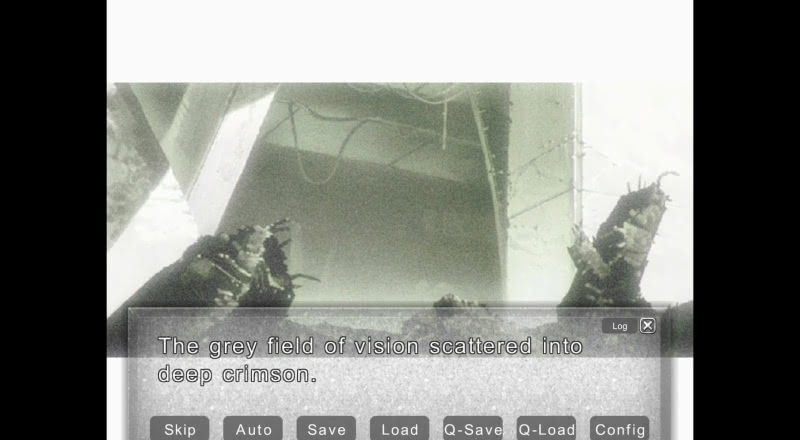
However, I did not read too far into it since I had already read the original Deja Vu version. The only reason I opted for the ONScripter-EN original is because it is more in line with my interest in reviewing early ONScripter localizations.
40 Days and Nights of Rain Overview
I am somewhat limited in how much I can say about the novel’s story in a spoiler-free format, but I will give enough of an introduction so that readers can have a general idea of what the novel is about.
40 Days and 40 Nights of Rain is set in a world mired in what appears to be a war without end. The view-point protagonist of the novel is a soldier named Yuu who is often called “Tin Plate” by those around him on account of his apparent lack of emotions. The opening scene of the novel takes us inside Yuu’s mind in battle. After that short opening, we, along with Yuu, are transported to a small and quiet town just off the front-line. Curiously, the town is being pummeled by non-stop rain. Yuu passes his days aimlessly, staying at an inn frequented by his fellow soldiers, but not interacting with them, all the while being tormented by a certain dream.
While walking in the rain one day, Yuu happens upon a curious girl. She is odd in many respects. Firstly, one would not expect to see a child in the town, although Yuu concluded it was likely that she was a war orphan. The girl has silver-white hair, which is not an expected hair color in the novel’s world. She is intent on walking in the rain and prone to falling down as she looks at the sky. Yuu engages her and discoversthat she had a good heart, but she is shy, awkward, and prone to bursting into tears. Yuu opts to take the hungry, clumsy girl back to the inn, where she quickly becomes popular with the innkeeper and the battle-hardened soldiers.
The innkeeper sees to it that the girl – who reveals that her name is Kyrie – has a room and food and that Yuu will take care of her. The girl expresses her desire to see the world, and Yuu, his heart beating just a little, begins accompanying her on walks around the quiet town. Readers of the novel will pick up on the fact that there is probably more to Kyrie than Yuu initially assumes, but the extent to which that may be true is beyond the scope of a spoiler-free review.
My Review
Below, I will review 40 Days and 40 Nights of Rain in various topical sub-sections. Note that I will assess A Happy Valentine separately – but everything save for my notes on the length of 40 Days and the Writing and Story Overview is generally applicable to A Happy Valentine.
Length and Game play
40 Days and 40 Nights of Rain should take most readers who are working through it carefully somewhere in the neighborhood of an hour and change to read. While it is a short novel in the grand scheme of things, it would have been on the longer-end of the freeware al|together visual novels had it been submitted to one of the festivals.
There is no game play to speak of in 40 Days and 40 Nights of Rain – it is an entirely kinetic visual novel with no choices or post-game extras.
Aesthetics
This is among the more aesthetic of the 2000s freeware Japanese visual novels I have reviewed – less for any one thing than the overall package.
40 Days and 40 Nights of Rain has no character sprites/portraits – relying only on backgrounds for its visuals. It makes use of letterboxing, which is unusual for novels of the type but not unprecedented. Its letterboxing effect reminds me of Narcissu and A Winter’s Tale, with the feel being more similar to the former but the overall execution being more similar to the latter.
The backgrounds appear to be a mix between stock photos with heavy filters and hand-drawn backgrounds. While none of the location backgrounds are ground-breaking, I credit the novel for having a distinct and cohesive aesthetic. The town backgrounds are almost entirely white and gray – giving the town the feeling of antiseptic emptiness the novel is going for. The interior of the inn is ever-so-slightly warmer, with a hint of brown. We see some color in Yuu’s haunting dream of his past – with warm greens and yellows from a time before war.
The most striking backgrounds feature Kyrie – who appears often as a part of images even though the novel does not make use of character portraits. Kyrie’s backgrounds tend to feature her striking white hair and blue eyes and utilize more blue than the backgrounds without a character. They have an appealing watercolor story-book aesthetic that is reminiscent of circle 17’s The Caged Vagrant, all the while fitting in with the less detailed stock backgrounds.
40 Days and 40 Nights of Rain has a low-key melancholic sound-track and notably shares some songs with Satomoi Shiba’s excellent True Remembrance, which predated it in Japan (more on that later). If I could lodge one complaint – the war sound-effects heard in the opening scene are a touch too loud.
While 40 Days and 40 Nights of Rain is not an ambitious audio-visual piece, it features some of the better painted backgrounds of the freeware novels we have reviewed thus far and is among the most aesthetically coherent. Most importantly, the look and feel of the novel fits its story and themes.
Localization Review
As a prefatory note – I cannot read Japanese and thus can only assess how Deja Vu’s English localization reads in and of itself.
40 Days and 40 Nights of Rain reads fairly well on the whole – which is no surprise given my similar assessment of Deja Vu’s localization A Dream of Summer. The English script is not without its niggles, however. There were instances when it was difficult to tell who is speaking – especially in scenes in the inn where there are speakers other than Yuu and Kyrie (this was also an issue in limited instances featuring just Yuu and Kyrie). It is worth noting that identifying the speaker has been an issue in some other similar localization projects from the era. While I did not note any glaring typos that disturbed my reading, some individual lines read a bit clunky – which could be on account of the source material struggling with some of the more abstract points of the script or the localization. The novel struggled a bit with action scenes, but there are not many of those.
On the whole, 40 Days and Nights of Rain reads well but I would grade the English script as being middle-of-the-road in terms of readability when compared to the al|together localizations.
Writing and Story Overview
My first thought when reading 40 Days and 40 Nights of Rain – especially after the early introduction of Kyrie – was that it reminded me very much of True Remembrance, which in addition to being a fellow mid-2000s freeware Japanese visual novel, is among my favorite visual novels overall. (See my full review of True Remembrance.) True Remembrance was set in an isolated, walled off town, set aside for the treatment of individuals suffering from pandemic depression (there are indications that the outside world is bleak). Its main protagonists are a matter-of-fact man and a silver-haired girl with unusual speech patterns and a tendency to burst into tears. 40 Days is set in a town just away from the front-lines of an endless war tearing the world asunder. We have a matter-of-fact jaded man and a silver-haired girl as the lead pair, and the girl has unusual speech patterns and a tendency to burst into tears. I have seen some reviews compare it to Key’s classic visual novel Planetarian, which is similarly set in a post-apocalyptic world with a rough male protagonist – but in that case the heroine is a robot girl tour guide from the past. The comparisons may be inevitable for anyone who reads 40 Days after True Remembrance or Planetarian – and neither comparison does 40 Days any favors considering the superlative quality of the other two novels. But 40 Days is, on the whole, a solid novel in its own right with a few rough edges, so let us set aside those comparisons and review it on its own.
While three characters other than Yuu have notable dialogue (the inn-keeper, one of the soldiers, and an elderly woman who feeds the pigeons), 40 Days is primarily a two-character piece.
Yuu is the view-point protagonist and I came away with a mixed view of how effective he is in that role. His “Tin Plate” nickname accurately describes him in that he shows no outward emotions or obvious drive to do much of anything beyond exist from one moment to the next until he is summoned back to the battlefield. The issue with Yuu, so to speak, is that this description also applies to much of his internal narration. Yuu is often limited to describing what is happening in front of him, and he often lacks much interest in it. While this is somewhat of an issue – it also highlights how he begins to change in small ways after taking an interest in helping the clumsy Kyrie by bringing her back to the inn so that she could be cared for. Despite being a man of few words – Yuu proves to not be cryptic. His recurring dream reveals a great deal of how he came to be the empty man we meet and that backstory, which is presented without any surprise twists with respect to Yuu himself, adequately sets up his quasi-parental relationship with Kyrie and how her presence in his dreary world helps him regain a small part of himself that he had locked away.
I cannot say too much about Kyrie beyond the obvious points in a spoiler-free format. Readers familiar with these sorts of pieces will most likely pick up on the fact that there is probably more to the apparent orphan girl, with her unusual silver hair, stumbling around in a mostly desolate rain-soaked town with a stated desire to see the world within a short period of time. Her determination to venture out into the rain and her odd mannerisms betray that there is something different about her, and a certain mid-story conversation between Kyrie and Yuu regarding the odd weather in the the town all but seals that Kyrie is a unique character. The portraits of her are quite pretty and the novel makes a good effort to shift the reader’s perception of her from pity (on the first meeting) to respecting her determination for whatever end she seeks. It also does a good job of highlighting that she is supposed to be adorable (that emphasis makes more sense here than it did with the heroine of The Dandelion Girl) – from her klutziness and subsequent apologies to her radiant happiness when she has the opportunity to feed the pigeons. There is an obvious point to why she becomes especially attached to Yuu and why she takes a liking to the inn-keeper and the battle-hardened men who see in her the families they have lost or left behind or would almost certainly never have again and why they all show a single lost girl in a world without hope a small bit of kindness. Readers will not be able to shake the likely correct feeling that there is more to her.
Turning to the issues beyond it being sometimes difficult to discern who is speaking, I quote from an April 21, 2007 review of the novel by Demian at the now-defunct visual-novels[dot]net:
The main problem with 4D4N would be its length. While not excessively long, the middle parts aren’t very interesting and serve little to the overall plot. There’s very much a sense of “get on with it already” in many parts.
I concur with Demian’s take. There were stretches in the middle when I thought something to the effect of “get on with it already” – we can call these the quasi-slice-of-life parts of the novel. I would not dismiss the slow-paced midsection as completely insignificant. That Yuu warms up just a bit while spending time with Kyrie is relevant to the progression of the story. The issue is likely grounded in the fact that Yuu, granting some development, is not a compelling narrator. Kyrie, granting her hidden-depths, still talks and acts more like a little girl than a character who can compensate for a taciturn lead. Given the cast, 40 Days would have benefited from being a little bit shorter.
In the aesthetics section – I praised the novel for using its limited visuals and soundtrack to effectively capture a gray world without much hope for the future. The script mostly does a decent job of matching the theme. Here, Yuu’s blunt descriptions of the present and his past give readers the clear idea that everyone is living day-to-day with the bleak understanding that most, if not all of them, have no home to return to. The fact the rain never stops also aligns with the idea that there will be no happy ending to this story. But there are points when the script and Yuu struggle with describing the world. The script is a bit cumbersome when dealing with its small number of action scenes or with genuine horror. It adequately paints a picture of the town in which most of the novel takes place as not being lived in, but I would have liked a richer description of it given the fact that we know there are at least some civilians who stayed behind and no one found the presence of a presumed orphan girl to be unsurprising. One could venture how meeting additional characters from the town and hearing their stories (or even focusing a bit more on some of the soldiers) could have given readers a better understanding of life in a dying world.
There is a final twist at the end of the novel. Reviewer Damien described the final twist as “very surprising” – I would not quite go that far. The particular direction it goes with one of its main two characters may not be what most readers would have on their bingo cards, but Kyrie lets slip enough in a couple of instances in the middle of the story that I would not call the final reveal surprising. (I will add that the reader is greeted with a significant clue shortly after starting the game, but I leave it up to future readers to find the clue.) My personal, spoiler-free assessment of the ending is mixed. It does resolve Kyrie’s character and brings a certain sense of closure for Yuu – but there is a central aspect of the ending, let us say its purpose, which was not adequately foreshadowed. To the extent one compares 40 Days to True Remembrance, this is one area in which it comes up well short. True Remembrance did an excellent job setting up its final twist and was sure-footed in understanding what it wanted to convey to the reader. I understand what 40 Days did and what it was inspired by, but it did not fully color inside its own lines. Its conclusion clears the good enough threshold, but more could have been done to make it meaningful in the context of the work itself.
Companion Review: A Happy Valentine
A Happy Valentine is a spin-off side-story to 40 Days and it only takes about 10 minutes to read. It has its own separate installer and executable – so it is functionally a different visual novel set within the four corners of 40 Days and 40 Nights of Rain’s story. As I noted, I ran the original Deja Vu Windows ONScripter-EN version of the novel on Linux with WINE in the same way I ran 40 Days.
As a threshold matter, I incorporate by reference my assessment of the visuals and music from 40 Days since, with the exception of one CG scene, A Happy Valentine reuses assets from its parent.
In A Happy Valentine, Kyrie decides that she wants to do something nice for everyone at the inn – but especially for Yuu – to return the kindness that they have shown her. Everyone conspires to help Kyrie prepare a surprise for Yuu, but his denseness and tendency to always assume the worst (understandable given his current lot in life) make their task difficult. It is made all but explicit in the novel that Kyrie was inspired to do something nice when she learned about it being Valentine’s Day, so the story indirectly helps us place 40 Days and 40 Nights of Rain on a calendar (not that the specific day and month are too important in a world that seems to have no future).
The A Happy Valentine day story is warmer than the sweetest moments of 40 Days, and Yuu comes off a bit more lifelike than he does in the main story. We know from the main story that no one in the cast has much to look forward to – but this side-story shows how Kyrie’s earnestness brought everyone together to make the best of a certain Valentine’s Day. There is no use in evaluating A Happy Valentine in and of itself since it exists within the broader 40 Days story, but I did come away thinking that it highlighted how parts of the middle section of the parent novel could have been written more effectively to provide readers with a better feel of the larger cast of characters.
Conclusion
The strongest point of 40 Days and 40 Nights of Rain is its aesthetic cohesion. It uses simple visuals and a well-chosen selection of stock music to paint a picture of a drowning world mired in war without end. The novel itself is decent – with a well-defined (if not always interesting) view-point protagonist and a charming and mysterious co-protagonist. It has its issues holding the reader’s interest in the mid section, and the ending, while acceptable, was not as well thought through as some of the better Japanese freeware novel efforts of the era. A Happy Valentine is a nice addenda and highlights how swaths of the parent novel could have been more engaging. Had 40 Days and 40 Nights of Rain piece been part of al|together, it would have fallen somewhere a few spots below the middle of my ranking. It is solid and recommendable for people who like pretty freeware Japanese visual novels from the era or who appreciate its post-apocalyptic themes. A Happy Valentine is a worthwhile short read for anyone who reads 40 Days, but it would not be intelligible without first reading the main novel.
